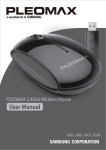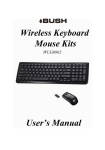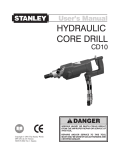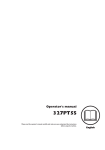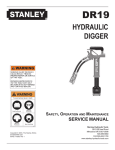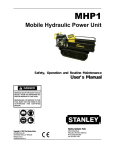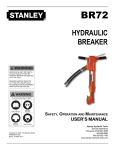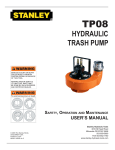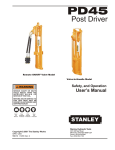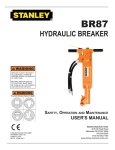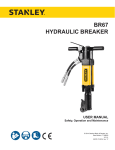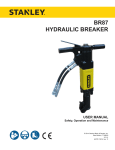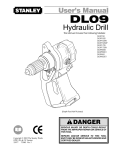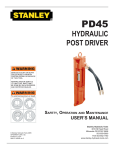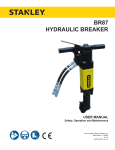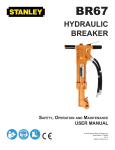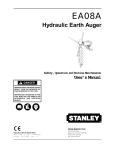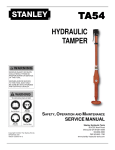Download BR67 Ser,31994
Transcript
BR67 HYDRAULIC BREAKER Safety, Operation and Service SERIOUS INJURY OR DEATH COULD RESULT FROM THE IMPROPER REPAIR OR SERVICE OF THIS TOOL. User's Manual REPAIRS AND / OR SERVICE TO THIS TOOL MUST ONLY BE DONE BY AN AUTHORIZED AND CERTIFIED DEALER. Read The Manual Wear Breathing Protection Wear Hearing Protection Wear Eye Protection Stanley Hydraulic Tools Copyright © 2001 The Stanley Works OPS/SERVICE USA & CE VERSION 31994 Ver 5 04/2003 3810 SE Naef Road Milwaukie, OR 97267-5698 USA Phone: (503) 659-5660 Fax: (503) 652-1780 TABLE OF CONTENTS Contents .............................................................................................................. 1 Certificate of Conformity ...................................................................................... 2 Safety Precautions .......................................................................................... 3 - 4 Tool Stickers and Tags ................................................................................... 5 - 6 Hydraulic Hose Requirements ........................................................................... 7 Hydraulic System Requirements ........................................................................ 8 Equipment Protection and Care .......................................................................... 9 Operation ........................................................................................................... 10 Service .......................................................................................................... 11-16 Accumulator Charging ....................................................................................... 17 Troubleshooting ................................................................................................ 18 Specifications .................................................................................................... 19 Accessories ....................................................................................................... 19 Special Tools ..................................................................................................... 19 Parts Lists .......................................................................................................... 20 Parts Illustration for Standard Handle Models .................................................. 21 Parts Illustration for Anti-Vibration Handle Models ........................................... 22 Warranty ............................................................................................................. 23 SERVICING BR67 BREAKERS: This manual contains safety, operation, Service and routine maintenance instructions. Stanley Hydraulic Tools recommends that servicing of hydraulic tools, other than routine maintenance, must be performed by an authorized and certified dealer. Please read the following warning. SERIOUS INJURY OR DEATH COULD RESULT FROM THE IMPROPER REPAIR OR SERVICE OF THIS TOOL. REPAIRS AND / OR SERVICE TO THIS TOOL MUST ONLY BE DONE BY AN AUTHORIZED AND CERTIFIED DEALER. For the nearest authorized and certified dealer, call Stanley Hydraulic Tools at one of the numbers listed on the back of this manual and ask for a Customer Service Representative. 1 CERTIFICATE OF CONFORMITY I, the undersigned: Hydraulic Tools Winterling, David Surname and First names Hereby certify that the construction plant or equipment specified hereunder: 1. Manufacturer: Stanley Hydraulic Tools, 3810 Naef Road, Milwaukie, Oregon USA 2. Representative in the Union: Stanley Svenska AB, Box 9054, 400 92 Göteborg, SWEDEN 3. Category: Hydraulic Hand Held Concrete Breaker 4. Make: Stanley Hydraulic Tools 5. Type: BR6713801, BR6717201, BR6717202, BR6717801 6. Type serial number of equipment: All 7. Year of manufacture: Beginning 2002 Has been manufactured in conformity with the provisions of the Machinery Directive 98/37/EC Harmonized standard applied: EN 792-4 We also declare that it meets the specification of Noise Directive 2000/14/EC, measured in accordance to the Conformity Evaluation Method set out in Annex VI para. 5 and evaluated during production as in Annex VI para. 6, 2 nd procedure. 8. Noise related value: 31 kg 9. Measured sound power on equipment representative of this type: 107 LwA 10. Guaranteed sound power level for this equipment: 112 LwA 11. Notified body for EC directive 2000/14/EC: 0404 SMP Svensk Maskinprovning AB Fyrisborgsgatan 3 754 50 Uppsala, SWEDEN 12. Special Provisions: None Issued at Stanley Hydraulic Tools, Milwaukie, Oregon USA Date: 8/21/02 Signature Position: Engineering Manager P/N 52574 Rev.1, 8/21/02 2 SAFETY SYMBOLS Safety symbols and signal words, as shown below, are used to emphasize all operator, maintenance and repair actions which, if not strictly followed, could result in a life-threatening situation, bodily injury or damage to equipment. This is the safety alert symbol. It is used to alert you to potential personal injury hazards. Obey all safety messages that follow this symbol to avoid possible injury or death. This safety alert and signal word indicate an imminently hazardous situation which, if not avoided, will result in death or serious injury. This safety alert and signal word indicate a potentially hazardous situation which, if not avoided, could result in death or serious injury. This safety alert and signal word indicate a potentially hazardous situation which, if not avoided, may result in minor or moderate injury. This signal word indicates a potentially hazardous situation which, if not avoided, may result in property damage. This signal word indicates a situation which, if not avoided, will result in damage to the equipment. IMPORTANT This signal word indicates a situation which, if not avoided, may result in damage to the equipment. Always observe safety symbols. They are included for your safety and for the protection of the tool. SOME HYDRAULIC FLUIDS ARE FLAMMABLE, NEVER ALLOW THESE HYDRAULIC FLUIDS TO COME IN CONTACT WITH AN OPEN FLAME. IF A HOSE WERE TO BURST OR IF A TOOL LEAK OCCURS NEXT TO AN OPEN FLAME, THESE HYDRAULIC FLUIDS WILL IGNITE AND COULD RESULT IN SERIOUS INJURY OR DEATH. LOCAL SAFETY REGULATIONS Enter any local safety regulations here. Keep these instructions in an area accessible to the operator and maintenance personnel. 3 SAFETY PRECAUTIONS Tool operators and maintenance personnel must always comply with the safety precautions given in this manual and on the stickers and tags attached to the tool and hose. These safety precautions are given for your safety. Review them carefully before operating the tool and before performing general maintenance or repairs. Supervising personnel should develop additional precautions relating to the specific work area and local safety regulations. If so, place the added precautions in the space provided on page 3. This tool will provide safe and dependable service if operated in accordance with the instructions given in this manual. Read and understand this manual and any stickers and tags attached to the tool and hoses before operation. Failure to do so could result in personal injury or equipment damage. Operator must start in a work area without bystanders. The operator must be familiar with all prohibited work areas such as excessive slopes and dangerous terrain conditions. Establish a training program for all operators to ensure safe operations. Do not operate the tool unless thoroughly trained or under the supervision of an instructor. Always wear safety equipment such as goggles, head protection, and safety shoes at all times when operating the tool. Do not inspect or clean the tool while the hydraulic power source is connected. Accidental engagement of the tool can cause serious injury. Do not operate this tool without first reading the Operating Instructions. Do not install or remove this tool while the hydraulic power source is connected. Accidental engagement of the tool can cause serious injury. Never operate the tool if you cannot be sure that underground utilities are not present. Underground electrical utilities present an electrocution hazard. Underground gas utilities present an explosion hazard. Other underground utilities may present other hazards. Do not wear loose fitting clothing when operating the tool. Loose fitting clothing can get entangled with the tool and cause serious injury. Supply hoses must have a minimum working pressure rating of 2500 psi/175 bar. Check fastener tightness often and before each use daily, also make sure all hose connections are tight. The hydraulic circuit control valve must be in the “OFF” position when coupling or uncoupling the tool. Wipe all couplers clean before connecting. Failure to do so may result in damage to the quick couplers and cause overheating. Use only lint-free cloths. Do not operate the tool at oil temperatures above 140° F/60° C. Operation at higher oil temperatures can cause operator discomfort and may cause damage to the tool. Do not operate a damaged, improperly adjusted, or incompletely assembled tool. To avoid personal injury or equipment damage, all tool repair, maintenance and service must only be performed by authorized and properly trained personnel. Do not exceed the rated limits of the tool or use the tool for applications beyond its design capacity. Always keep critical tool markings, such as labels and warning stickers legible. Always replace parts with replacement parts recommended by Stanley Hydraulic Tools. 4 TOOL STICKERS & TAGS SERIAL NO. STAMPING 11207 CIRCUIT "D" STICKER (CE Models Only) 58604 GUARANTEED SOUND POWER LEVEL STICKER (CE Models Only) 12542 NAME TAG SERIAL NO. STAMPING 28322 CE LABEL (CE Models Only) 28322 CE LABEL (CE Models Only) 11207 CIRCUIT "D" STICKER (CE Models Only) 58604 GUARANTEED SOUND POWER LEVEL STICKER (CE Models Only) 28409 COMPOSITE STICKER (CE Models Only) 28409 COMPOSITE STICKER (CE Models Only) 28380 MODEL STICKER (CE Models Only) 28376 NAME TAG (CE Models Only) or 12542 NAME TAG 11208 SHANK LENGTH STICKER (UK Models Only) D A N G E R D A N G E R 1. FAILURE TO USE HYDRAULIC HOSE LABELED AND CERTIFIED AS NON-CONDUCTIVE WHEN USING HYDRAULIC TOOLS ON OR NEAR ELECTRICAL LINES MAY RESULT IN DEATH OR SERIOUS INJURY. BEFORE USING HOSE LABELED AND CERTIFIED AS NON-CONDUCTIVE ON OR NEAR ELECTRIC LINES BE SURE THE HOSE IS MAINTAINED AS NON-CONDUCTIVE. THE HOSE SHOULD BE REGULARLY TESTED FOR ELECTRIC CURRENT LEAKAGE IN ACCORDANCE WITH YOUR SAFETY DEPARTMENT INSTRUCTIONS. 2. A HYDRAULIC LEAK OR BURST MAY CAUSE OIL INJECTION INTO THE BODY OR CAUSE OTHER SEVERE PERSONAL INJURY. The safety tag (p/n 15875) at right is attached to the tool when shipped from the factory. Read and understand the safety instructions listed on this tag before removal. We suggest you retain this tag and attach it to the tool when not in use. A DO NOT EXCEED SPECIFIED FLOW AND PRESSURE FOR THIS TOOL. EXCESS FLOW OR PRESSURE MAY CAUSE A LEAK OR BURST. B DO NOT EXCEED RATED WORKING PRESSURE OF HYDRAU LIC HOSE USED WITH THIS TOOL. EXCESS PRESSURE MAY CAUSE A LEAK OR BURST. C CHECK TOOL HOSE COUPLERS AND CONNECTORS DAILY FOR LEAKS. DO NOT FEEL FOR LEAKS WITH YOUR HANDS. CONTACT WITH A LEAK MAY RESULT IN SEVERE PERSONAL INJURY. D DO NOT LIFT OR CARRY TOOL BY THE HOSES. DO NOT ABUSE HOSE. DO NOT USE KINKED, TORN OR DAMAGED HOSE. 3. MAKE SURE HYDRAULIC HOSES ARE PROPERLY CONNECTED TO THE TOOL BEFORE PRESSURING SYSTEM. SYSTEM PRESSURE HOSE MUST ALWAYS BE CONNECTED TO TOOL "IN" PORT. SYSTEM RETURN HOSE MUST ALWAYS BE CONNECTED TO TOOL "OUT" PORT. REVERSING CONNECTIONS MAY CAUSE REVERSE TOOL OPERATION WHICH CAN RESULT IN SEVERE PERSONAL INJURY. 4. DO NOT CONNECT OPEN-CENTER TOOLS TO CLOSED-CENTER HYDRAULIC SYSTEMS. THIS MAY RESULT IN LOSS OF OTHER HYDRAULIC FUNCTIONS POWERED BY THE SAME SYSTEM AND/ OR SEVERE PERSONAL INJURY. 5. BYSTANDERS MAY BE INJURED IN YOUR WORK AREA. KEEP BYSTANDERS CLEAR OF YOUR WORK AREA. 6. WEAR HEARING, EYE, FOOT, HAND AND HEAD PROTECTION. 7. TO AVOID PERSONAL INJURY OR EQUIPMENT DAMAGE, ALL TOOL REPAIR MAINTENANCE AND SERVICE MUST ONLY BE PERFORMED BY AUTHORIZED AND PROPERLY TRAINED PERSONNEL. I M P O R TA N T I M P O R TA N T READ OPERATION MANUAL AND SAFETY INSTRUCTIONS FOR THIS TOOL BEFORE USING IT. READ OPERATION MANUAL AND SAFETY INSTRUCTIONS FOR THIS TOOL BEFORE USING IT. USE ONLY PARTS AND REPAIR PROCEDURES APPROVED BY STANLEY AND DESCRIBED IN THE OPERATION MANUAL. USE ONLY PARTS AND REPAIR PROCEDURES APPROVED BY STANLEY AND DESCRIBED IN THE OPERATION MANUAL. TAG TO BE REMOVED ONLY BY TOOL OPERATOR. TAG TO BE REMOVED ONLY BY TOOL OPERATOR. SEE OTHER SIDE 15875 SEE OTHER SIDE 15875 SAFETY TAG P/N 15875 (shown smaller then actual size) 5 TOOL STICKERS & TAGS BR67 BREAKER Division of The Stanley Works Stanley Hydraulic Tools SERIAL NO. FLOW 7-9 GPM/26-34 LPM PRESS 1500-2000 PSI 105-140 BAR ACCUMULATOR CHG 600 PSI/42 BAR NITROGEN NAME TAG STICKER p/n 12542 or p/n 29203 (shown smaller than actual size) A name tag sticker is attached to the breaker. Never exceed the flow and pressure levels specified on this sticker. The information listed on the name tag sticker must be legible at all times. Replace this sticker if it becomes worn or damaged. A replacement is available from your local Stanley distributor. CE STICKER p/n 28322 (shown approx size) STANLEY LABEL STICKER p/n 28376 (shown smaller than actual size) CIRCUIT "D" STICKER p/n 11207 (shown smaller than actual size) GUARANTEED SOUND POWER LEVEL STICKER p/n 58604 (shown smaller than actual size) 6" ✘ ✔ 6¼" COMPOSITE STICKER p/n 28409 (shown smaller than actual size) MODEL No. LABEL p/n 28380 (CE Models Only) HEX SHANK STICKER p/n 11208 (UK Models Only) 6 HYDRAULIC HOSE REQUIREMENTS HOSE TYPES Hydraulic hose types authorized for use with Stanley Hydraulic Tools are as follows: 1 Certified non-conductive 2 Wire-braided (conductive) 3 Fabric-braided (not certified or labeled non-conductive) Hose 1 listed above is the only hose authorized for use near electrical conductors. Hoses 2 and 3 listed above are conductive and must never be used near electrical conductors. To help ensure your safety, the following DANGER tags are attached to all hose purchased from Stanley Hydraulic Tools. DO NOT REMOVE THESE TAGS. If the information on a tag is illegible because of wear or damage, replace the tag immediately. A new tag may be obtained at no charge from your Stanley Distributor. 1 CERTIFIED NON-CONDUCTIVE HOSE D A N G E R D A N G E R 1 FAILURE TO USE HYDRAULIC HOSE LABELED AND CERTIFIED AS NON-CONDUCTIVE WHEN USING HYDRAULIC TOOLS ON OR NEAR ELECTRIC LINES MAYRESULT IN DEATH OR SERIOUS INJURY. FOR PROPER AND SAFE OPERATION MAKE SURE THAT YOU HAVE BEEN PROPERLY TRAINED IN CORRECT PROCEDURES REQUIRED FOR WORK ON OR AROUND ELECTRIC LINES. 3. DO NOT EXCEED HOSE WORKING PRESSURE OR ABUSE HOSE. IMPROPER USE OR HANDLING OF HOSE COULD RESULT IN BURST OR OTHER HOSE FAILURE. KEEP HOSE AS FAR AWAY AS POSSIBLE FROM BODY AND DO NOT PERMIT DIRECT CONTACT DURING USE. CONTACT AT THE BURST CAN CAUSE BODILY INJECTION AND SEVERE PERSONAL INJURY. 2. BEFORE USING HYDRAULIC HOSE LABELED AND CERTIFIED AS NON-CONDUCTIVE ON OR NEAR ELECTRIC LINES. WIPE THE ENTIRE LENGTH OF THE HOSE AND FITTING WITH A CLEAN DRY ABSORBENT CLOTH TO REMOVE DIRT AND MOSISTURE AND TEST HOSE FOR MAXIMUM ALLOWABLE CURRENT LEAKAGE IN ACCORDANCE WITH SAFETY DEPARTMENT INSTRUCTIONS. 4. HANDLE AND ROUTE HOSE CAREFULLY TO AVOID KINKING, ABRASION, CUTTING, OR CONTACT WITH HIGH TEMPERATURE SURFACES. DO NOT USE IF KINKED. DO NOT USE HOSE TO PULL OR LIFT TOOLS, POWER UNITS, ETC. 5. CHECK ENTIRE HOSE FOR CUTS CRACKS LEAKS ABRASIONS, BULGES, OR DAMAGE TO COUPLINGS IF ANY OF THESE CONDITIONS EXIST, REPLACE THE HOSE IMMEDIATELY. NEVER USE TAPE OR ANY DEVICE TO ATTEMPT TO MEND THE HOSE. DO NOT REMOVE THIS TA G DO NOT REMOVE THIS TA G This tag is attached to all certified non-conductive hose. 6. AFTER EACH USE STORE IN A CLEAN DRY AREA. SEE OTHER SIDE SIDE 1 SEE OTHER SIDE (shown smaller than actual size) SIDE 2 2 AND 1 3WIRE-BRAIDED AND FABRIC-BRAIDED (NOT CERTIFIED OR LABELED NON-CONDUCTIVE) HOSE This tag is attached to all conductive hose. DO NOT REMOVE THIS TA G 2. FOR PROPER AND SAFE OPERATION MAKE SURE THAT YOU HAVE BEEN PROPERLY TRAINED IN CORRECT PROCEDURES REQUIRED FOR WORK ON OR AROUND ELECTRIC LINES. 5. CHECK ENTIRE HOSE FOR CUTS CRACKS LEAKS ABRASIONS, BULGES, OR DAMAGE TO COUPLINGS IF ANY OF THESE CONDITIONS EXIST, REPLACE THE HOSE IMMEDIATELY. NEVER USE TAPE OR ANY DEVICE TO ATTEMPT TO MEND THE HOSE. 6. AFTER EACH USE STORE IN A CLEAN DRY AREA. 3. DO NOT EXCEED HOSE WORKING PRESSURE OR ABUSE HOSE. IMPROPER USE OR HANDLING OF HOSE COULD RESULT IN BURST OR OTHER HOSE FAILURE. KEEP HOSE AS FAR AWAY AS POSSIBLE FROM BODY AND DO NOT PERMIT DIRECT CONTACT DURING USE. CONTACT AT THE BURST CAN CAUSE BODILY INJECTION AND SEVERE PERSONAL INJURY. 4. HANDLE AND ROUTE HOSE CAREFULLY TO AVOID KINKING, CUTTING, OR CONTACT WITH HIGH TEMPERATURE SURFACES. DO NOT USE IF KINKED. DO NOT USE HOSE TO PULL OR LIFT TOOLS, POWER UNITS, ETC. DO NOT REMOVE THIS TA G D A N G E R D A N G E R 1 DO NOT USE THIS HYDRAULIC HOSE IN OR NEAR ELECTRIC LINES. THIS HOSE IS NOT LABELED OR CERTIFIED AS NON-CONDUCTIVE. USING THIS HOSE ON OR NEAR ELECTRICAL LINES MAY RESULT IN DEATH OR SERIOUS INJURY. SEE OTHER SIDE SEE OTHER SIDE SIDE 1 (shown smaller than actual size) SIDE 2 HOSE PRESSURE RATING The rated working pressure of the hydraulic hose must be equal or higher than the relief valve setting on the hydraulic system. 7 HTMA Requirements Hydraulic System Requirements Tool Category: Flow rate Tool Operating Pressure 20Lpm at 138bar BHTMA CATEGORY 30Lpm at 138bar BHTMA CATEGORY Type I Type II Type III 4-6 GPM (15-23 lpm) 2000 psi (138 bar) 7-9 GPM (26-34 lpm) 2000 psi (138 bar) 11-13 GPM (42-49 lpm) 2000 psi (138 bar) (at the power supply outlet) System relief valve setting (at the power supply outlet) Maximum back pressure (at tool end of the return hose) Measured at a max. fluid viscosity of: (at min. operating temperature) Temperature Sufficient heat rejection capacity to limit max. fluid temperature to: (at max. expected ambient temperature) Min. cooling capacity at a temperature difference of between ambient and fluid temps 2100-2250 2100-2250 2100-2250 (145-155 bar) (145-155 bar) (145-155 bar) 250 psi 250 psi 250 psi (17 bar) (17 bar) (17 bar) 400 SSU 400 SSU 400 SSU (82 centistokes) (82 centistokes) (82 centistokes) 140° F (60° C) 140° F (60° C) 140° F (60° C) 3 hp (2.24 kW) 40° F (22° C) 5 hp (3.73 kW) 40° F (22° C) 7 hp (5.22 kW) 40° F (22° C) NOTE: Do not operate the tool at oil temperatures above 140° F (60° C). Operation at higher temperatures can cause operator discomfort at the tool. Filter Min. full-flow filtration sized for flow of at least: 25 microns 30 GPM (114 lpm) 25 microns 30 GPM (114 lpm) 25 microns 30 GPM (114 lpm) (For cold temp. startup and max. dirt-holding capacity) Hydraulic fluid Petroleum based (premium grade, anti-wear, non-conductive) Viscosity (at min. and max. operating temps) 100-400 SSU* (20-82 centistokes) 100-400 SSU* (20-82 centistokes) 100-400 SSU* (20-82 centistokes) NOTE: When choosing hydraulic fluid, the expected oil temperature extremes that will be experienced in service determine the most suitable temperature viscosity characteristics. Hydraulic fluids with a viscosity index over 140 will meet the requirements over a wide range of operating temperatures. *SSU = Saybolt Seconds Universal NOTE: These are general hydraulic system requirements. See tool Specification page for tool specific requirements. 8 Equipment Protection and Care In addition to the Safety Precautions on page 3 & 4 of this manual, observe the following for equipment protection and care. • Make sure all couplers are wiped clean before connection. • The hydraulic circuit control valve must be in the “OFF” position when coupling or uncoupling hydraulic tools. Failure to do so may result in damage to the quick couples and cause overheating of the hydraulic system. • Always store the tool in a clean dry space, safe from damage or pilferage. • Make sure the circuit PRESSURE hose (with male quick disconnect) is connected to the “IN” port. The circuit RETURN hose (with female quick disconnect) is connected to the opposite port. Do not reverse circuit flow. This can cause damage to internal seals. • Always replace hoses, couplings and other parts with replacement parts recommended by Stanley Hydraulic Tools. Supply hoses must have a minimum working pressure rating of 2500 psi/172 bar. • Do not exceed the rated flow (see Specifications) page 19 in the manual for correct flow rate and model number. Rapid failure of the internal seals may result. • Always keep critical tool markings, such as warning stickers and tags legible. • Do not force a small breaker to do the job of a large breaker. • Keep tool bit sharp for maximum breaker performance. Make sure that tool bits are not chipped or rounded on the striking end. • Never operate a breaker without a tool bit or without holding it against the work surface. This puts excessive strain on the breaker foot. • Tool repair should be performed by experienced personnel only. • Make certain that the recommended relief valves are installed in the pressure side of the system. • Do not use the tool for applications for which it was not intended. 9 OPERATION PREOPERATION PROCEDURES PREPARATION FOR INITIAL USE Each unit as shipped has no special unpacking or assembly requirements prior to usage. Inspection to assure the unit was not damaged in shipping and does not contain packing debris is all that is required. CHECK HYDRAULIC POWER SOURCE 1. Using a calibrated flowmeter and pressure gauge, check that the hydraulic power source develops a flow of 7-9 gpm/26-34 lpm at 1500-2000 psi/105-140 bar. 2. Make certain the hydraulic power source is equipped with a relief valve set to open at 2100-2250 psi/145-155 bar minimum. 3. Check that the hydraulic circuit matches the tool for open-center (OC) operation. CHECK TOOL 1. Make sure all tool accessories are correctly installed. Failure to install tool accessories properly can result in damage to the tool or personal injury. 2. There should be no signs of leaks. CONNECT HOSES 1. Wipe all hose couplers with a clean lint-free cloth before making connections. 2. Connect the hoses from the hydraulic power source to the hose couplers on the breaker. It is a good practice to connect the return hose first and disconnect it last to minimize or avoid trapped pressure within the breaker. 3. Observe flow indicators stamped on hose couplers to be sure that oil will flow in the proper direction. The female coupler is the inlet coupler. NOTE: The pressure increase in uncoupled hoses left in the sun may result in making them difficult to connect. When possible, connect the free ends of operating hoses together. OPERATING PROCEDURES 1. Observe all safety precautions. 2. Move the hydraulic circuit control valve to the "ON" position. 3. Place the tool bit firmly on the surface to be broken. 4. Squeeze the trigger to start the breaker. Adequate down pressure is very important. NOTE: Partially depressing the trigger allows the tool to operate at a slow speed, making it easy to start the tool bit into the surface to be broken. 3. The tool should be clean, with all fittings and fasteners tight. CHECK TRIGGER MECHANISM 1. Check that the trigger operates smoothly and is free to travel between the "ON" and "OFF" positions. COLD WEATHER OPERATION If the breaker is to be used during cold weather, preheat the hydraulic fluid at low engine speed. When using the normally recommended fluids, fluid temperature should be at or above 50° F/10° C (400 ssu/82 centistokes) before use. 10 SERVICE INSTRUCTIONS Good maintenance practices will keep the breaker on the job and increase its service life. A very important maintenance practice is to keep the hydraulic fluid clean at all times. Contaminated hydraulic fluid causes rapid wear and/or failure of internal parts. Follow the procedures contained in the HYDRAULIC SYSTEM REQUIREMENTS section of this manual to ensure peak performance from the tool. Never disassemble the breaker unless proper troubleshooting procedures have isolated the problem to an internal part. Then, only disassemble it to the extent necessary to replace the defective part. KEEP CONTAMINANTS SUCH AS DIRT AND GRIT AWAY FROM INTERNAL PARTS AT ALL TIMES. 3. Remove the valve cap assembly (74) from the top of the handle. Loosen the 5/8- inch hex charging valve lock nut 1-1/2 turns. Discharge the accumulator down to approximately 20 psi/1.4 bar. IMPORTANT Do not completely discharge the accumulator at this time. 4. Remove the four side rod nuts (66). Remove the breaker foot assembly (61 or 87) by tapping the top of the flange with a plastic or rubber hammer to drive it from the flow sleeve tube (40). Remove the o-ring, rod wiper and cup seal (62, 63 & 65) from the foot using the proper o-ring tools to avoid damage to grooved surfaces. Always determine and correct the cause of the problem prior to reassembly. Further wear and tool failure can result if the original cause is not corrected. 5. Remove the handle assembly (59) from the flow sleeve assembly (40) by tapping on alternate ends of the side rods (46) with a plastic or rubber hammer while pulling on the handle. DISASSEMBLY AUTOMATIC VALVE BODY & ACCUMULATOR ASSEMBLY PRIOR TO DISASSEMBLY • Clean the exterior of the tool. • Obtain a seal kit to replace all seals exposed during disassembly. Note the orientation of seals before removing them. Install new seals in the same position as original seals. HANDLE & ACCUMULATOR DISASSEMBLY Standard Handle Models Refer To Illustration 2. 1. Secure the breaker in a bench vise, with the “IN” and “OUT” ports up, clamping on the flow sleeve tube between the side rods. Soft vise jaws are recommended. 2. Remove the pigtail hose assemblies. Note: The breaker is full of fluid and will drip from the ports when the hoses are removed. 6. If the automatic valve body (56) remains in the handle assembly, the accumulator assembly and automatic valve body can be removed by placing a 3/ 4-inch hex deep socket with a 6-inch/15 cm extension over the charging valve (21) and tapping the extension with a plastic or rubber hammer. Note: Make sure the thin washer (42) between the automatic valve body and the accumulator chamber (79) is properly located in its counterbore before driving the automatic valve body and accumulator out of the handle. 7. If the accumulator cylinder (70) remains inside the handle, it can be removed using the accumulator cylinder puller (Part Number 05640) which seats on the inside lower contour of the accumulator cylinder. Use a rod that extends through the charge valve hole in the handle and drive out the cylinder by tapping on the rod or use a slide hammer through the 1/2-inch/ 12.5 mm hole provided in the puller. 8. If the entire accumulator assembly was removed in step 4, discharge the accumulator assembly completely and proceed to step 7. 9. To remove the accumulator chamber and diaphragm (51) from the accumulator cylinder, Place 11 the assembly on disassembly tools (Part Numbers 05508 and 04910). Use a rag in the bottom of the flow sleeve removal tube (Part Number 04910) to protect the accumulator chamber. Drive the chamber and diaphragm out by tapping or pushing with an arbor press on the charge valve end while protecting the valve with a 3/4-inch hex deep socket. 10. Squeeze the accumulator diaphragm and slide it off the charge valve end of the accumulator chamber. 3. Remove the handle assembly from the flow sleeve assembly by tapping on alternate ends of the side rods with a plastic or rubber hammer while pulling on the handle. 4. If the automatic valve body (56) remains in the handle assembly, it can be removed by using a special tool (30939 sleeve & 05046 bearing puller). 11. Remove the cup seal (43) and back-up washer (37) from the accumulator chamber. 5. The spacer is removed by using a 7/8 inch collet (30956 collet) and a bearing puller from the 05064 bearing puller kit. 12. Secure the accumulator chamber in a vise with soft jaws to remove the charging valve. 6. The sintered filter (33) and o-rings (34) are removed by simply picking them out. IMPORTANT Avoid damage to the counterbore of the chamber. TRIGGER 13. Remove the trigger (12) from the handle by driving out the 1/4-inch/6.4 mm diameter Spirol Pin. ACCUMULATOR 7. Clamp the handle assembly in a vice with soft jaws and unscrew the charge valve (21). Make sure the accumulator has been discharged before removing the charge valve. 8. Unscrew the accumulator plug (52) using special tool 29135 accumulator plug wrench. VALVE SPOOL 9. Lift out the accumulator diaphragm (51). 14. Remove the valve spool (7) by driving out two 3/16 x 1-3/8 inch/5 mm x 35 mm roll pins (77) and tap the end of the spool. The valve spring (8) will eject the spool from the bore bringing the washer and bushing with it. 15. Remove the valve spool spring by turning the handle on end. 16. Remove the orifice plug (30) from the bottom of the valve spool bore with a long 1 1/4-inch hex wrench. TRIGGER 10. Remove 4 capscrews (9) and lift off the top plate (92). 11. Unscrew the two pivot screws (49) and lift out the two handles (11 & 13) and four springs (24 & 25). Remove the lever (10) and trigger (12) from the handle by driving out the roll pins (23). VALVE SPOOL HANDLE & ACCUMULATOR DISASSEMBLY Anti-Vibration Handle Models Refer to Illustration 1. 1. Remove the modified plug (20) and discharge the accumulator completely. 2. Remove the four side rod nuts (66). Remove the foot assembly (61) by tapping the top of the flange with a plastic or rubber hammer to drive it from the flow sleeve tube (40). Remove the o-ring, rod seal and cup seal (62, 63 & 65) from the foot using the proper o-ring tools to avoid damage to grooved surfaces. 12. Remove the spirolox retaining ring, then remove the SAE plug (32) located at the bottom of the spool bore. Pick out the spring (8) and then push the valve spool (7) out. FLOW SLEEVE TUBE DISASSEMBLY 1. Follow steps 1 through 3 of the HANDLE AND ACCUMULATOR DISASSEMBLY for STANDARD HANDLES or steps 1 through 3 for ANTI-VIBRATION HANDLES. 2. If the automatic valve body remains in the flow sleeve tube, complete the following steps. 12 a. Remove the washer (42) and piston (17). b. Place the split rings (p/n 04908) between the automatic valve body and flow sleeve tube. c. Place the flow sleeve assembly (with split rings in place) on the flow sleeve removal tube (p/n 04910) with the automatic valve body down. d. Using an arbor press and an aluminum disc or accumulator cylinder puller (p/n 05640) to protect the flow sleeve, push on the flow sleeve (45) to remove the automatic valve body. IMPORTANT Use a rag in the bottom of the removal tube to protect the automatic valve body when it drops out. e. The automatic valve body, automatic valve (47), four 5/16 x 2-inch/8 mm x 51 mm push pins (54) from the flow sleeve and two 3/16 x 1-1/4 inch/5 mm x 32 mm push pins (48) from the automatic valve body will come out. 3. Remove the flow sleeve from the flow sleeve tube (40) as follows: a. Place the split ring (p/n 04908) on top of the flow sleeve removal tube (p/n 04910). b. Place the flow sleeve tube assembly on top of split rings. c. With an arbor press, and an aluminum disc or accumulator cylinder puller (p/n 05640) to protect the flow sleeve, push the flow sleeve out of the tube. IMPORTANT Use a rag in the bottom of the removal tube to protect the flow sleeve when it drops out. 4. The hex bushing (53) is removed by pressing it out using a 100 ton press. EASI-RIDETM FOOT To remove the collar support (83) and spring (82) follow the steps below. 1. Follow steps 2 and 3 above to remove the latch, detent and spring. 2. Press down on the collar support (83) from the latch end to retract it from the retaining ring (a long bolt with large washers may be placed through the foot assembly to hold the collar support in the retracted position). 3. Using a small punch, insert it through the hole in the foot (87) and press on the retaining ring (85). Hook the retaining ring with a hook type tool and pull it out. 4. Pull the collar support and spring out. 5. The hex bushing (81) is removed by pressing it out using a 100 ton press. ASSEMBLY PRIOR TO ASSEMBLY • Clean all parts with a degreasing solvent. • Ensure that all seals exposed during disassembly are replaced with new parts. • Apply clean grease or o-ring lubricant to all parts during assembly. • Obtain a seal kit so that all seals exposed during disassembly can be replaced. Note: For orientation of parts identified in the following procedures, see the parts illustration. HANDLE ASSEMBLY Standard Handle Models FOOT DISASSEMBLY 1. Follow steps 2 and 3 of the HANDLE AND ACCUMULATOR DISASSEMBLY for STANDARD HANDLES or steps 3 and 4 for ANTI-VIBRATION HANDLES. 2. Remove the latch (67) by first removing the nut (68), washer (58) and bolt (60). 3. The detent (70) and spring (69) can be removed after the latch is removed. Refer to Illustration 2. 1. Install the orifice plug (30) in the bottom of the valve spool bore with a long 1/4-inch hex wrench. 2. Replace (in this order) the spring (8), valve spool (Caution: the valve spool is a two peice spool, a spool and spool rod with an o-ring attached to the spool rod. Make sure the spool rod is properly seated in the spool and that they do not separate during installation into the valve spool bore. (7), bushing (4) (with wiper ring (3) toward stem end of valve spool) and washer (2) in the valve spool Bore. 13 Secure by driving the two 3/16 x 1-5/8 inch/5 x 41 mm spirol pins (77) through the handle on top of the washer. 3. Replace the trigger (12). Install a 1/4-inch/6.4 mm diameter spirol pin (72). To ease installation of the pin, align the trigger with a 1/4-inch/6 mm diameter rod or punch from the opposite side of the handle. HANDLE ASSEMBLY Anti-Vibration Handle Models Refer to Illustration 1. 1. Install the orifice plug (30) through the bottom port (OUT PORT) into the threaded hole near the bottom of the spool bore. 2. Place the accumulator valve block (50) on a bench top with trigger handle side down. Lubricate an o-ring (34) and place it into the bottom of the bore in the valve block. Place the sintered filter (33) on top of this o-ring. Lubricate another o-ring (34) and place it on top of the sintered filter. 9. Place the top plate (92) over the top of the accumulator valve block and secure with 4 capscrews (9). 10. Set the completed assembly aside. FLOW SLEEVE TUBE ASSEMBLY The best way to assemble the flow sleeve (45), automatic valve body (56) and piston (17) is by using an assembly fixture such as that shown in figure 1. The fixture permits the parts to be stacked vertically during the assembly process. After the parts are stacked, the handle assembly can then be placed on top of the stacked parts and tapped into place. The assembly fixture shown in figure 1 should be constructed of aluminum or brass and should be at least 3-1/2 in/88 mm high but no more than 8 in/203 mm high. The instructions in this section require the use of the assembly fixture shown in figure 1. If a fixture cannot be acquired, use an assembled foot assembly and clamp it into a vice. 3. Lubricate o-ring (35) and install it onto the spacer (36). Install the backup washer (37) and cup seal (43) (with lips facing out) into the bore in the spacer. Install the completed assembly into the accumulator valve block. 4. Install the SAE plug (32). 5. Turn the valve block over (trigger handle side up). Install (in this order) the spring (8), valve spool (Caution: the valve spool is a two peice spool, a spool and spool rod with an o-ring attached to the spool rod. Make sure the spool rod is properly seated in the spool and that they do not separate during installation into the valve spool bore. (7), bushing (with rod wiper (3), o-ring (6) and o-ring (5) installed) and washer into the valve spool bore. Secure by installing the spirolox retaining ring (1). Figure 1. 1. Lubricate the flow sleeve (45) and install it into the flow sleeve tube (40). Orientation is as shown in the parts illustration. The flow sleeve has a wide groove around the outside of one end. Install this end first. Then place the flow sleeve tube and flow sleeve on top of the assembly fixture shown in figure 1. 6. Install the springs (24) and (25). 7. Install the trigger (12) into the trigger handle (13) and secure with a spirol pin (23). Install the lever (10) into the trigger handle and secure with a spirol pin. Install the completed assembly onto the accumulator valve block and secure with a pivot screw (49) applied with Kopr-Kote antiseize compound and Loctite on the threads. 8. Install the handle (11) onto the accumulator valve block and secure with a pivot screw applied with KoprKote antiseize compound and Loctite on the threads. 2. Apply grease and install an o-ring (44) onto the flow sleeve tube. 3. Apply lubricant and install 4 push pins (54) into the holes in the top of the flow sleeve. One end of each push pin contains a machined surface. This surface must be facing up as each push pin is installed. Each push pin must slide freely in or out of the hole in the flow sleeve. If a push pin does not slide freely or seems to stick, the hole may contain contamination or the top edge of the hole contains a burr. Remove burrs with a deburring tool, clean the 14 hole thoroughly and try the push pin again. 4. Tap the roll pin (55) into the hole on the automatic valve body (56). 5. Apply grease and install an o-ring (44) onto the valve body (56). 6. Lubricate and install 2 push pins (48) into the holes in the valve body. One end of each push pin contains a machined surface. This surface must be facing up as each push pin is installed. Each push pin must slide freely in or out of the hole in the valve body. If a push pin does not slide freely or seems to stick, the hole may contain contamination or the top edge of the hole contains a burr. Remove burrs with a deburring tool, clean the hole thoroughly and try the push pin again. 7. Lubricate the automatic valve (47) and install it into the valve body. The automatic valve must freely slide back and forth. If it does not, the valve body or valve may contain contaminants or the bore of the valve body contains burrs. Remove the push pins and scrub the bore of the valve body with emery cloth and then thoroughly clean the bore, push pin holes and valve. Reinstall the push pins and valve. 8. Grasp the automatic valve body and valve so that one or more fingers are gripping the valve to prevent it and the push pins from falling out when the valve body and valve are turned upside down (roll pin facing down). Place the assembly on top of the flow sleeve making sure the roll pin aligns with the appropriate hole in the flow sleeve. 9. Lubricate and install the piston (17) into the top of the automatic valve body. 10. Install the washer (42), smaller diameter first, over the stem of the piston and onto the automatic valve body. 11. If you are working with a standard handle model, proceed to the steps below. If you are working with an anti-vibration handle model, proceed to step 1. under "INSTALLING THE HANDLE ASSEMBLY, for AntiVibration Handle Models". ACCUMULATOR - Standard Handle Models Only 12. Screw the charging valve (21) into the accumulator chamber. 13. Apply a light coating of WD-40 to the accumulator diaphragm (51) and accumulator chamber (79) and slide the accumulator diaphragm onto the accumulator chamber from the charging valve end. 14. Use grease or rubber lubricant on the inside of the accumulator cylinder (70) and the outside diameter of the diaphragm. Push the accumulator chamber and diaphragm, charging valve end first, halfway into the accumulator cylinder. The parts are assembled from the end of the cylinder with the chamfer on the outside diameter. Be sure the accumulator diaphragm is free of wrinkles and the seal bead is in its groove before completing the assembly. An arbor press is required to completely seat the assembly using short movements during the last 1/2-inch/12 mm of travel to gently seat the diaphragm. IMPORTANT Do not use a hammer or powered arbor press. 15. Test charge the accumulator assembly as follows: a. Place the accumulator assembly in a vise with soft jaws clamping on ends of the accumulator chamber. Do not overtighten the vise and distort the accumulator cylinder. b. Loosen the charging valve lock nut 1-1/2 turns. c. Charge the accumulator with nitrogen to 600 psi/41 bar. (It may be necessary to charge it 5075 psi/3.4-5 bar high to overcome the pressure drop through the charging system.) d. Check for leaks. 16. Apply grease and install a new o-ring (35) around the accumulator cylinder. Apply grease and install a new back-up washer (37) and cup seal (43) (lips facing out) in the accumulator chamber counterbore. 17. Install the accumulator assembly over the stem of the piston and down to the top of the automatic valve body. INSTALLING THE HANDLE ASSEMBLY Standard Handle Models Refer to Illustration 2. 1. Apply grease liberally to the o-ring surfaces on the accumulator, automatic valve body, flow sleeve tube and to the bore of the handle assembly. 15 2. Place the handle assembly over the top of the accumulator and then tap it down until the lower part of the handle block covers the o-ring on the flow sleeve tube. Nm using special tool 29135 Accumulator Plug Wrench. 3. Lay the completed handle and flow sleeve assembly over being careful to prevent movement of the flow sleeve when the assembly fixture is removed. 9. Charge the accumulator with 600 psi/42 bar nitrogen as described in the "CHARGING THE ACCUMULATOR" section. 4. Place the completed assembly horizontally (oil ports up) in a vice with soft jaws and clamp on the flow sleeve tube. 10. Install the plug (20). 5. Follow steps 1 through 6 of the "FOOT ASSEMBLY" for installation of the foot assembly. 6. Charge the accumulator with 600 psi/42 bar nitrogen as described in the "CHARGING THE ACCUMULATOR" section. 7. Install the valve cap (74). INSTALLING THE HANDLE ASSEMBLY Anti-Vibration Handle Models Refer to Illustration 1. 1. Apply grease liberally to the o-ring surfaces on the automatic valve body, flow sleeve, the cup seal in the spacer and the bore of the handle assembly. 2. Place the handle assembly over the piston and automatic valve being careful to align the spacer with the stem of the piston. Tap the handle down until the lower part of the handle block covers the o-ring on the flow sleeve tube. 3. Lay the completed handle and flow sleeve assembly over being careful to prevent movement of the flow sleeve when the assembly fixture is removed. 4. Place the completed assembly horizontally (accumulator up) in a vice with soft jaws and clamp on the flow sleeve tube. 8. Install the charge valve (21). FOOT ASSEMBLY 1. If the hex bushing was removed, reinstall it using a 50 ton press making sure the hex is properly aligned for the tool bit. 2. If servicing an EASI-RIDETM foot, install the spring (82) and collar support (83) followed by the retaining ring (85). 3. Apply grease and install the rod wiper (63) below the seal insert. 4. Install the seal carrier (64) into the bottom of the flow sleeve tube. 5. Apply grease and install the cup seal (65) into the seal carrier. 6. Apply grease and install the o-ring (62). 7. Install the spring (69) and detent (70). Install the two rubber sleeves (57). Place a washer (58) over the bolt (60), place the latch (67) between the two ears on the foot and push the bolt through it. Place a washer (58) on the thread end of the bolt and then thread on the nut (68). Tighten the nut until the treaded end of the bolt is even with the outside surface of the nut. 8. Install the foot over the side rods and into the flow sleeve tube. 9. Install the four side rod nuts. Tighten in 20 ft Ib/25 Nm increments to 75 ft Ib/100 Nm in a cross pattern. 5. Follow steps 1 through 6 of the "FOOT ASSEMBLY" for installation of the foot assembly. ACCUMULATOR 6. Lubricate the diaphragm (51) inside and out with WD40 and install it into the handle. 7. Apply Kopr-Kote antiseize to the thread surfaces of the accumulator plug (52) and handle assembly and install the accumulator plug. Tighten to 200 lb. ft./270 16 CHARGING THE ACCUMULATOR CHARGING THE ACCUMULATOR To check or charge the accumulator the following equipment is required: • Accumulator tester (Part Number 02835). • Charging assembly (Part Number 15304) (includes a guage w/snub valve, hose and fitting). • NITROGEN bottle with a 800 psi/56 bar minimum charge. 1. On charge valves containing 5/8 inch hex locking nuts, first loosen the locking nut 1-1/2 turns. 2. Holding the chuck end of the Stanley tester (p/n 02835), turn the gauge fully counterclockwise to ensure the stem inside the chuck is completely retracted. 3. Thread the tester onto the charging valve of the tool accumulator (do not advance the gauge-end into the chuck end. Turn as a unit). Seat the chuck on the accumulator charging valve and hand tighten only. 4. Advance the valve stem by turning the gauge- end clockwise. 5. Connect the charge fitting on the hose to the charge valve on the 02835 Tester. 6. With the gauge and snub valve attached to the nitrogen bottle, and with the snub valve closed, open the nitrogen bottle valve. NOTE: It may be necessary to adjust the charge at 650-700 psi/45-48 bar to overcome any pressure drop through the charging system. 7. While watching the pressure gage open the snub valve allowing the gauge to read 600 to 700 psi/42 to 48 bar, close the snub valve on the charging assembly and also on the nitrogen bottle, remove the charging assembly from the accumulator tester. 8. Turn the gauge end of the tester fully counterclockwise to retract the plunger in the chuck. Then remove the tester from the charge valve. 9.On charge valves containing 5/8 inch hex locking nuts, tighten the locking nut. TESTING THE ACCUMULATOR PRESSURE 1. Follow instructions 1 through 4 under "CHARGING THE ACCUMULATOR". 2. Read the pressure on the gauge (pressure should be between 500 & 600 psi/35 & 42 bar. 3. If the pressure is low, recharge the tool. Gauge w/ Snub Valve Charge Fitting Nitrogen Tank Charging Valve 31254 ACCUMULATOR CHARGE KIT Includes: Gauge w/ snub valve, hose w/charge fitting, 02835 tester, and box (not pictured). Hose Gauge Chuck 02835 TESTER 17 TROUBLESHOOTING If symptoms of poor performance develop, the following chart can be used as a guide to correct the problem. supplying the correct hydraulic flow and pressure to the breaker as listed in the table. Use a flowmeter known to be accurate. Check the flow with the hydraulic oil temperature at least 80°F/27°C. When diagnosing faults in operation of the tool, always check that the hydraulic power source is Breaker does not run. Breaker does not hit effectively. Breaker operates slow. Power unit not functioning. Check power unit for proper flow and pressure (7-9 gpm / 26-34 lpm, 2000 psi / 140 bar). Couplers or hoses blocked. Remove restriction. Presssure and return line hoses reversed at ports. Be sure hoses are connected to their proper ports. Mechanical failure of piston or automatic valve. Have inspected and repaired by authorized dealer. Power unit not functioning. Check power unit for proper flow and pressure (7-9 gpm / 26-34 lpm, 2000 psi / 140 bar). Couplers or hose blocked. Remove restriction, Low accumulator charge (pressure hose will pulse more than normal). Have recharged by authorized dealer. Fluid too hot (above 140° F / 60° C). Provide cooler to maintain proper fluid temperature. Collar support not sliding freely in the foot bore (Easi-RideTM) Remove, clean and replace as required. Low oil flow from power unit. Check power source for proper flow. High backpressure. Check hydraulic system for excessive backpressure and correct as required. Orifice Plug Blocked. Remove restriction. 18 SPECIFICATIONS Pressure Range .......................................................................................................................................... 1500-2000 psi/104-140 bar Blows Per Minute ............................................................................................................................................................... 1300 to 1800 Maximum Back Pressure .................................................................................................................................................. 250 psi/17 bar Flow Range ....................................................................................................................... (HTMA Type II) 7-9 gpm/26-34 lpm EHTMA Category D ..................................................................................................................................................... 30 lpm @ 138 bar Porting ............................................................................................................................................................................... -8 SAE O-ring Couplers ....................................................................................................................... HTMA/EHTMA Flush Face Type Male & Female Connect Size and Type .................................................................................................................................. 3/8 in. Male Pipe Adapter Hose Whips ....................................................................................................................................................................................... Yes Weight Standard Handle Model .............................................................................................................................................. 67 lbs / 30 kg Anti-Vibration Handle Model ....................................................................................................................................... 75 lbs / 34 kg Overall Length (Standard Handle) .................................................................................................................................... 27 in. / 69 cm (Anti-Vibration Handle)..........................................................................................................................29 in. / 73.6 cm Overall Width - Standard Handle .................................................................................................................................... 16 in. / 40.6 cm Overall Width - Anti-Vibration Handle .......................................................................................................................... 18 in. / 45.75 cm Maximum Fluid Temperature ................................................................................................................................................ 140° F/60° C Sound Pressure Level at Operator...........................................................................................................................................99 dBA Guaranteed Sound Power Level ............................................................................................................................................. 112 dBA Vibration Level (Standard Handle Model) ................................................................................................................................ 20.0 m/s2 (Antivibration Handle Model)..........................................................................................................................10.2 m/s2 ACCESSORIES DESCRIPTION PART NUMBER 1-1/8 in. Hex x 6 in. Shank Clays Spade, 5-1/2 in./13.9 cm Blade Asphalt Cutter, 5 in./12.7 cm Blade, 11 in./27.9 cm long UC Moil Point, 14 in./35.6 cm UC Chisel, 3 in./76 mm, 14 in./35.6 cm long UC Chisel, 1 in./25 mm, 14 in./35.6 cm long UC Asphalt Wedge, 14 in./35.6 cm long UC Ground Rod Driver, 1 inch Rod Moil Point, Heavy Duty-18 inches long UC Clay Spade, 5-1/2 inch Blade Detachable Shank Brick Wedge 02331 02332 02333 02334 03990 08106 04176 n/a n/a n/a n/a 1-1/4 in. Hex x 6 in. Shank 09262 02335 02336 02337 02338 08119 04367 04404 04405 17782 08118 SPECIAL TOOLS DESCRIPTION PART NUMBER O-ring Tool Kit Spil Ring (Auto Valve Removal Spacer Flow Sleeve Removal Tube Accumulator Disassembly Tool Accumulator Cylinder Puller Accumulator Plug Wrench Sleeve 04337 04908 04909 04910 05508 05640 29135 30939 Collet, 7/8 inch 30956 Accumulator Tester Accumulator Charge Kit 02835 31254 Accumulator Charge Assembly 15304 USAGE General Service of Seals Auto Valve Removal - Requires 04910 Flow Sleeve Installation Used with 04908 & 05508 For Standard Handle Models Only For Standard Handle Models Only For Anti-Vibration Models Only Removal of Auto Valve Body from Handle - Anti-Vibration Models Only Removal of Spacer from Handle - Anti-Vibration Models Only (Part of 05064 Bearing Puller Kit) Accumulator Charging Includes: 02835 Tester, 15304 Accumulator charge assy, and 372047 Box. Includes: Liquid Filled Gauge w/Snub Valve, Hose w/Charge Fitting. 19 20 ----20500 20541 20498 02494 11207 01605 09546 12832 06891 20510 26452 04795 16732 26448 04062 03973 03972 04068 29203 04064 04063 04054 04069 04071 04065 04571 20508 26596 26574 26449 04081 04597 04067 07890 04066 01269 04985 ----04983 04598 04076 22 23 24 25 26 27 28 29 30 31 32 33 34 35 36 37 38 39 40 41 42 43 44 45 46 47 48 49 50 51 52 53 54 55 56 57 58 59 60 61 24067 04055 04056 26451 01362 00293 20515 04058 07628 20511 28369 24958 29045 ------------04070 --------20510 20499 1 2 3 4 5 6 7 8 9 10 11 12 13 14 15 16 17 18 19 20 21 Item No 21089 20500 20541 20498 02494 11207 01605 09546 12832 06891 20510 26452 04795 16732 26448 04062 03973 03972 04068 29203 04064 04063 04054 04069 04071 04065 04571 20508 26596 26574 26449 04081 04597 04067 07890 04066 01269 04985 ----04983 04598 04076 24067 04055 04056 26451 01362 00293 20515 04058 07628 20511 28369 24958 31565 26599 24964 16607 04070 24948 29508 20510 20499 ANTI-VIB HANDLE Without With Trigger Trigger Lock Lock Part Part No No ----04055 04056 04057 01362 00293 04077 04058 ------------04053 ----------------04070 ------------04051 09349 ----------------02494 ----01605 09546 04350 ------------------------04062 --------04068 ----04064 04063 04054 04069 04071 04065 04571 --------04059 ----04081 04597 04067 07890 04066 01269 04985 07971 04983 04598 04076 ----04055 04056 04057 01362 00293 04077 04058 ------------11434 ----------------04070 ------------04051 09349 ----------------02494 11207 01605 09546 04350 ------------------------04062 --------04068 ----04064 04063 04054 04069 04071 04065 04571 --------04059 ----04081 04597 04067 07890 04066 01269 04985 11435 04983 04598 04076 STANDARD HANDLE Without With Trigger Trigger Lock Lock Part Part No No 1 1 1 1 1 1 1 1 4 1 1 1 1 1 1 1 1 1 1 1 1 1 1 2 2 2 2 1 2 2 1 1 1 1 2 1 1 1 1 1 1 1 1 1 2 1 1 1 2 2 1 1 1 1 1 4 1 1 2 2 1 1 1 1 Qty • • • • • • • Retaining Ring Washer Rod Wiper Bushing O-ring, 5/16 x 7/16 x 1/16 O-ring, 11/16 x 7/8 x 3/32 Valve Spool (The valve spool contains 3 parts) Spring Capscrew Lever Handle Trigger Trigger Handle Pin Spring SAE Plug, -10 Piston Trigger Lock Pin Plug Charge Valve Valve Cap (Not Pictured) Roll Pin Spirol Pin Spring Spring Handle Grip Circuit Type "D" Sticker O-ring Hose Assy (Incld item 28) Orifice Plug O-ring, -912, R17 Plug Sintered Filter O-ring, 2-218-70D O-ring, 2-230-90D Spacer Back-up Washer Male Coupler Body Female Coupler Body Flow Sleeve Tube Name Tag, BR67 Washer Cup Seal O-ring, 2-7/8 x 3-1/8 x 1/8 Flow Sleeve Side Rod Automatic Valve Push Pin Pivot Screw Accumulator Valve Block Accumulator Diaphragm Accumulator Plug Hex Bushing, 1-1/8 x 6 in. (for 04598 foot) Hex Bushing, 1-1/4 x 6 in. (for 04598 foot) Push Pin Roll Pin Automatic Valve Body Rubber Sleeve Spring Washer Handle Bolt Foot (for 04081 or 04597 Hex Bushing) (Incld 63 & 64) Foot Assy, 1-1/8 x 6 in. Hex (USA & CE except UK models only) (Incld items 53, 57, 58, 60, 61, 63, 64 & 66-70) Description ----11638 --------- ----------------26450 11208 00077 ----- ----- ----------------26450 --------- 12294 04073 04074 05464 04072 04075 01837 04984 04983 08411 28322 28409 58604 ------------------------------------11230 ------------11234 ----------------- 04599 ----- 04073 04074 05464 04072 04075 01837 04984 04983 08411 ----28409 58604 ------------------------------------------------------------------------- 04599 04061 11430 07517 07518 11230 07514 08115 08116 11234 28380 07522 ----28376 11614 04061 ----07517 07518 ----07514 08115 08116 --------07522 12542 ----11614 ------------------------------ ----- 07524 07525 01003 11435 11431 11432 ----11208 00077 11638 07524 07525 12294 04073 04074 05464 04072 04075 01837 04984 04983 08411 28322 28409 58604 04050 04052 00844 22891 08855 04073 04074 05464 04072 04075 01837 04984 04983 08411 ----28409 58604 04050 04052 00844 22891 ----- 04599 04599 STANDARD HANDLE Without With Trigger Trigger Lock Lock Part Part No No 1 1 1 1 1 1 1 1 1 1 1 1 1 1 1 1 1 1 1 1 1 1 1 1 1 1 1 1 1 1 1 1 1 1 1 1 1 1 1 1 1 1 1 Qty • • Description • • Foot Assy, 1-1/4 x 6 in. Hex (USA & CE except UK models only) (incld items 53, 57, 58, 60, 61, 63, 64 & 66-70) Breaker Foot Assy. 1-1/8 Under/Water (Model-BR67320 Only) O-ring, 2-5/8 x 2-7/8 x 1/8 90D Rod Wiper Seal Insert Cup Seal Side Rod Nut Latch Stop Nut Spring Detent CE Sticker (CE models only) Composite Sticker Guaranteed Sound Power Level Sticker 112 Valve Cap Assy O-ring, 1.047 x 1.279 x .116 90D Spirol Pin Spring Pin Sticker Accumulator Chamber Spring Hex Bushing, 1-1/8 x 6 in. (for 11614 EZ Foot) Hex Bushing, 1-1/4 x 6 in. (for 11614 EZ Foot) Hex Bushing, 1-1/4 x 6-1/4 in. (for 12294 EZ foot) Spring Collar Support, 1-1/8 in. (for 11614 EZ Foot) Collar Support, 1-1/4 in. (for 11614 EZ Foot) Collar Support, 1-1/4 in. (for 12294 EZ foot) Model Sticker (CE models only) Retaining Ring Name Tag Stanley Label Foot, EZ (for 07517 or 07518 Bushing) (USA & CE except UK models only) (Incld 64 & 87) Foot, EZ, (for 11230 Bushing) (UK models only) (Incld 64 & 87) Foot Assy, EZ, 1-1/8 x 6 Hex (USA & CE except UK models only) (Incld items 57, 58, 60, 63, 64, 66-70, 81-83, 85, 87) Foot Assy, EZ, 1-1/4 x 6 Hex (USA & CE except UK models only) (Incld items 57, 58, 60, 63, 64, 66-70, 81-83, 85, 87) Foot Assy, EZ, 1-1/4 x 6-1/4 Hex (UK models only) (Incld items 53, 57, 58, 60, 61, 63, 64 & 66-70, 81-83, 85, 87) Button Handle Lock Pin Key Top Plate Hex Shank Sticker (UK models only) Retaining Ring • Denotes part in seal kit SEAL KIT 04596 NOTE: Use Part Number and Part Name when ordering. FOR MORE SPECIFIC DESCRIPTIONS OF THE VARIOUS BREAKER MODELS, SEE "MODEL DESCRIPTIONS" ON PAGE 8. 88 89 90 91 92 93 94 87 84 85 86 82 83 62 63 64 65 66 67 68 69 70 71 72 73 74 75 76 77 78 79 80 81 Item No ANTI-VIB HANDLE Without With Trigger Trigger Lock Lock Part Part No No BR67 PARTS LIST 21 22 WARRANTY Stanley Hydraulic Tools (hereinafter called “Stanley”), subject to the exceptions contained below, warrants new hydraulic tools for a period of one year from the date of sale to the first retail purchaser, or for a period of 2 years from the shipping date from Stanley, whichever period expires first, to be free of defects in material and/or workmanship at the time of delivery, and will, at its option, repair or replace any tool or part of a tool, or new part, which is found upon examination by a Stanley authorized service outlet or by Stanley’s factory in Milwaukie, Oregon to be DEFECTIVE IN MATERIAL AND/OR WORKMANSHIP. EXCEPTIONS FROM WARRANTY FREIGHT COSTS: Freight costs to return parts to Stanley, if requested by Stanley for the purpose of evaluating a warranty claim for warranty credit, are covered under this policy if the claimed part or parts are approved for warranty credit. Freight costs for any part or parts which are not approved for warranty credit will be the responsibility of the individual. SEALS & DIAPHRAGMS: Seals and diaphragms installed in new tools are warranted to be free of defects in material and/or workmanship for a period of 6 months after the date of first usage, or for a period of 2 years from the shipping date from Stanley, whichever period expires first. CUTTING ACCESSORIES: Cutting accessories such as breaker tool bits are warranted to be free of defects in material and or workmanship at the time of delivery only. ITEMS PRODUCED BY OTHER MANUFACTURERS: Components which are not manufactured by Stanley and are warranted by their respective manufacturers. a. Costs incurred to remove a Stanley manufactured component in order to service an item manufactured by other manufacturers. ALTERATIONS & MODIFICATIONS: Alterations or modifications to any tool or part. All obligations under this warranty shall be terminated if the new tool or part is altered or modified in any way. NORMAL WEAR: any failure or performance deficiency attributable to normal wear and tear such as tool bushings, retaining pins, wear plates, bumpers, retaining rings and plugs, rubber bushings, recoil springs, etc. INCIDENTAL/CONSEQUENTIAL DAMAGES: To the fullest extent permitted by applicable law, in no event will STANLEY be liable for any incidental, consequential or special damages and/or expenses. FREIGHT DAMAGE: Damage caused by improper storage or freight handling. LOSS TIME: Loss of operating time to the user while the tool(s) is out of service. IMPROPER OPERATION: Any failure or performance deficiency attributable to a failure to follow the guidelines and/or procedures as outlined in the tool’s operation and maintenance manual. MAINTENANCE: Any failure or performance deficiency attributable to not maintaining the tool(s) in good operating condition as outlined in the Operation and Maintenance Manual. HYDRAULIC PRESSURE & FLOW: Any failure or performance deficiency attributable to excess hydraulic pressure, excess hydraulic back-pressure, or excess hydraulic flow. REPAIRS OR ALTERATIONS: Any failure or performance deficiency attributable to repairs by anyone which in Stanley’s sole judgement caused or contributed to the failure or deficiency. MIS-APPLICATION: Any failure or performance deficiency attributable to mis-application. “Mis-application” is defined as usage of products for which they were not originally intended or usage of products in such a matter which exposes them to abuse or accident, without first obtaining the written consent of Stanley. WARRANTY REGISTRATION: STANLEY ASSUMES NO LIABILITY FOR WARRANTY CLAIMS SUBMITTED FOR WHICH NO TOOL REGISTRATION IS ON RECORD. In the event a warranty claim is submitted and no tool registration is on record, no warranty credit will be issued without first receiving documentation which proves the sale of the tool or the tools’ first date of usage. The term “DOCUMENTATION” as used in this paragraph is defined as a bill of sale, or letter of intent from the first retail customer. A WARRANTY REGISTRATION FORM THAT IS NOT ALSO ON RECORD WITH STANLEY WILL NOT BE ACCEPTED AS “DOCUMENTATION”. NO ADDITIONAL WARRANTIES OR REPRESENTATIONS This limited warranty and the obligation of Stanley thereunder is in lieu of all other warranties, expressed or implied including merchantability or fitness for a particular purpose except for that provided herein. There is no other warranty. This warranty gives the purchaser specific legal rights and other rights may be available which might vary depending upon applicable law. 23 Stanley Hydraulic Tools Division of The Stanley Works 3810 S.E. Naef Road Milwaukie, Oregon 97267-5698 Phone: 503/659-5660 Fax: 503/652-1780


























